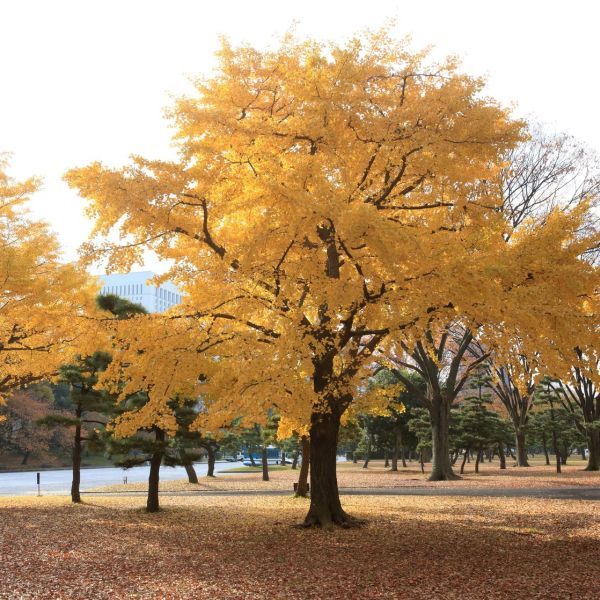Over 200 million years ago during the late Triassic period an order of tree, the Ginkgoales, was widespread throughout Asia, America and Europe. This was during the early onset of dinosaurs. Our world did not resemble the globe we take for granted today. Instead, all landmasses were interconnected to form one large supercontinent, which we now know as Pangea. Fast-forward to present day, and there exists only one lonely survivor of the order of the Ginkgoales, the newly planted Ginkgo biloba now sitting proudly in Library Square in Trinity. Luckily for us, the extinct dinosaurs are no longer present to feed on this tree.
I spoke to Professor Jenny McElwain, a palaeobotanist, and Chair of the Department of Botany here at Trinity, to discuss the significance of this highly evolved tree lineage. Many texts have described the Ginkgo biloba as being relatively unchanged over the past 200 million years. McElwain assures me that, while the Ginkgo tree is indeed a ‘living fossil’, the over-simplification of the tree being described as ‘unchanged’ couldn’t be further from the truth. She adds: “The leaf has a really distinctive bilobed leaf, kind of a double-lobed leaf, and the fossils look so similar to modern leaves that we just presume that it’s genetically unchanged. But that’s incorrect… Ginkgo once had many species, but today we have only a single living species, in a single genus, in a single family”. While the family has shrunk in diversity, Ginkgo has managed to survive. As in other evolving species, it has undergone extensive genetic change.
Another Trinity alumnus, Botany graduate Jessie Dolliver, did her undergraduate thesis on Ginkgoales. By studying the fossil record, she observed that Ginkgoales have what is known as “Whole Genome Duplications”. This means the tree’s genome was doubled at some point in time. This is quite a unique feature for many species but is not uncommon amongst angiosperms. Amazingly, the tree’s capacity to double its genome enabled it to survive two mass extinction events, the Triassic-Jurassic boundary and the Cretaceous-Tertiary boundary. While other groups such as the dinosaurs were virtually wiped out, the possession of an extra set of each gene gave the Ginkgos the ability to adapt and to adjust to extreme environments.
“An extra set of each gene gave the Ginkgos the ability to adapt and to adjust to extreme environments.”
The Ginkgo biloba is a dioecious plant, so male and female reproductive organs are present on separate individuals. A curious, but somewhat controversial theory put forward by Peter Crane in his book, ‘Ginkgo: The Tree That Time Forgot’, partially credits the Ginkgo’s survival to its ‘sex-switching’ branches. In times of stress, a female tree could possibly sprout male branches. By doing so, an entire tree can be fertilised, and multiple seeds can be produced. McElwain says we must consider that many botanical experiments have taken place over the years, particularly during the Victorian times. Often, a male branch would be grafted onto a female branch to study its effects. So, Crane’s theory remains controversial as it is unknown whether this ‘sex-switching branches’ phenomenon is naturally-occurring or not.
Gingko biloba is an ideal species for Library Square, as it is extremely resilient. Following the bombing in 1945 at Hiroshima, Japan, six Ginkgos were seen to be budding a mere 1.3 kilometres from the hypocentre of the bombing. They have come to be known as the ‘Bearer of Hope’, within this region which is an uplifting message to convey during these times. Additionally, these trees are extremely long-lived, and can live up to 5,000 years old. They are ideal trees for urban areas, as they are resistant to urban pollution. While our temperate Irish climate is regarded as suboptimal for this species, future climate change will see it flourish in Ireland.
A group of German palaeontologists attempted to uncover the food dinosaurs would have eaten before the existence of flowering plants. They studied a collection of fossil species, including Ginkgo and examined their nutritional quality. They found that Ginkgo had a decent nutritional quality and may have been browsed on by passing dinosaurs. In addition, the fleshy, smelly fruit from the female tree would have been attractive to dinosaurs. Today, Ginkgo fruit and seeds are primarily used in cooking and traditional medicine.
The uncertainty surrounding Ireland’s future climate means that it is difficult to predict which plant species will become commonplace in our landscape in the years to come. On a positive note, it is clear that the resilient nature of this tree will ensure that they persevere as they have done for millions of years and will continue to be enjoyed by visitors to Trinity for the years ahead.






